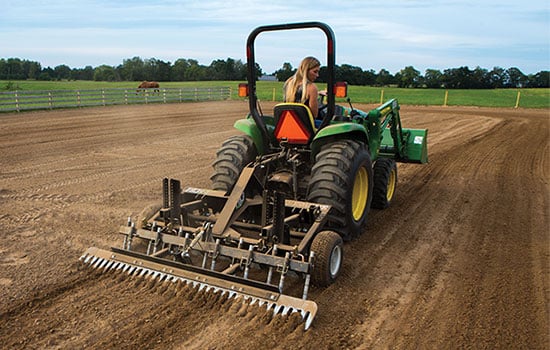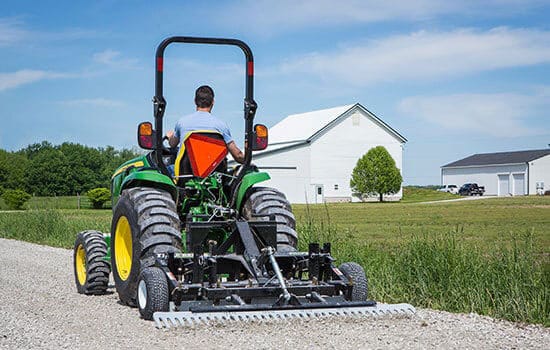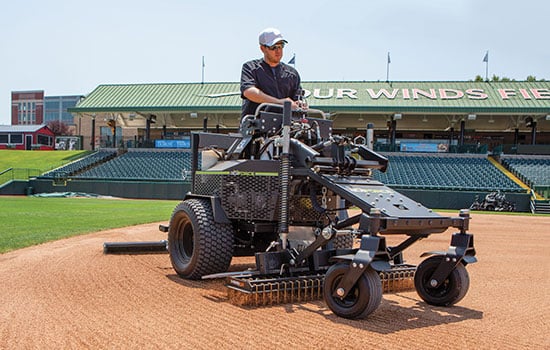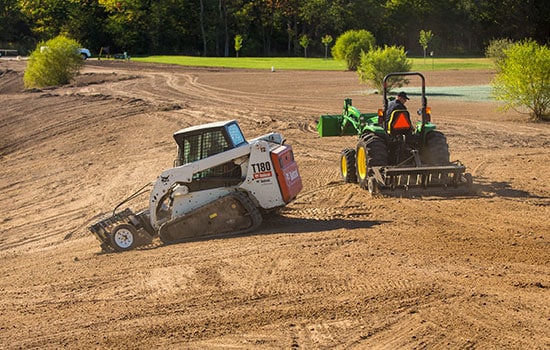Henderson Turf Significantly Improves Bottom Line With ABI Attachments
Transcript
My name is Scott Holmes and I’m one of the owners of ABI Attachments and I’m here in central Ohio with Trent Gillam who is a general manager for Henderson Turf.
Yes sir. I was brought on two years ago to try to bring the company into the future. And in that I was looking for new tools to use because our Harley Rakes were continuously breaking down and I came across ABI on on the Internet and made a call up and came up for a day and spent a day with Kevin.
Right. Kevin is my partner. Inventor of all this equipment.
Came up and spent a day with him in the field and went back that year and bought one TR3 Rake and one SR3 Rake, used it through the Fall and then this Spring bought a Packer/Seeder, three more TR3 Rakes and two more SR3 Rakes.
So you mentioned Harley Rake, right? What is it that made you want to move from that type of seedbed preparation to something new?
Well we also have a sod farm in southern Ohio and when we prep our sod fields we go in and we rip the soil real deep and then we pack all the seed on and then you know we don’t use any sort of mulch cover anything in our sod fields. So I kept looking at why aren’t we doing that same thing on our projects and with the Harley Rake, we weren’t able to get that deep seedbed penetration that we wanted and get that nice loose soil we’re only able to get maybe an inch of dust over top of the ground.
It’s just not designed to do that. You have one inch nubs.
Correct.
And it’s on a roller and that’s about the penetration you get.
Yes. We thought in our office that if we were able to rip the soil we’d be able to get a lot more water absorption because we had looser soil so when you ran the Harley Rake over top of a hard pan soil you still had that hard crust and the water when it hit it would hit the hard pan and we had a lot of washouts. So with ripping up the soil the ground was able to absorb a lot more moisture which then helped increase our germination.
So tell me a little bit about your your operation.
When I came on board two years ago we had roughly 25 employees. And with those 25 employees we were turning right around two million dollars a year in volume and our work consist of erosion control blanket sod installation and seed prep and insulation. So I came back and said Well let’s see if there’s not a way to improve our operation. How can we become more efficient and with our power rakes. We had a real hard time getting up close to any concrete or hard surfaces because they bounce a lot when they’re spinning. And so we always try to stay off our rule of thumb was to stay a foot off and then take a hand rake up with three or four hand guys and spend the next day with guys with rakes raking all day. I don’t want to rake all day. They don’t want to rake all day. So when I came and visited Kevin said use my tool and do all your edge work. And so we went out and and that’s what we started to do. And we we went from twenty five employees at about two million dollars and we’re down to 13 employees and our projections are two and a half million last year. We were we were able to produce more per crew with these tools than we were with our previous tools we’re using the Harley Rakes and the Rock Hounds.
You were telling me earlier that you had eight Harley Rakes. You had four crews.
Correct.
But you never had enough Hardy Rakes to fill your crews.
We always had we had a backup for every tractor so at a Harley Rake costing you somewhere between nine and ten thousand dollars apiece. We had a spare one for when the main one broke down. And at certain times we would have two or three broke down time and wouldn’t be able to go out and work because we didn’t have the tools to go out and work this year from March until the end of August. We haven’t had that as an obstacle for our operations team the ABI attachments don’t break down there’s not a lot of moving parts for the break down the Harley Rakes, you know, they have a lot of moving parts and pieces and bearings and things that can break on them.
One of things I want to talk to you about is the acceptance of these tools by your labors. I mean we’ve dealt with thousands of contractors and laborers through the years and we know that change seldom is fun. How did you guys respond to all this?
Well we showed up last Fall with a SR3 and a TR3 Rake. We put them basically with our most efficient crew that was using the Harley Rakes. They adapted pretty well and I was really excited about it last fall when I came back from Indiana with you guys. And so I spent some time out in the field with them I was more involved with the direct field operations. And so those guys got trained pretty thoroughly and they really bought onto the tools and were were able to help convince our owner that this was this was going to be a good idea moving forward because we had a significant investment to make moving into the 2015 season if we wanted to acquire more equipment. So we showed up with three more TR3 Rakes and two more SR3 Rakes. We took a sixty thousand dollar skid steer that before just had a bucket or a power rake on it. And now we put in it was really just used for general cleanup. And we took that sixty thousand dollar piece of equipment and now we’re able to go out and produce grading with it and finished product with it.
What we have found is that the tools are easier to use. I can take a everyday equipment operator and put him in that. And by the end of the day he’s figured out how to run it efficiently how to use it to its capabilities. If I take a person straight off the streets and put them on it there’s not a huge learning curve. You set your tires you set it to the grade that you want to rip and everything. And then it goes out and does its job. You don’t have to mess with raising and lowering the TR3 or the SR3 Rake. It pretty much a self leveling itself. It was designed to work that way it was designed to be operator friendly. And so our guys end up liking it better because it’s easier form the run. They put it down and they just go do their job.
The bottom line is you’ve increased your efficiency and lowered your labor costs.
All while continuing to grow our gross sales.
Exactly.
Our volumes continuing to grow and we’re not having to necessarily go out and hire a bunch of new staff or buy a bunch of new equipment. We’re finding ways to use the things that we already own and are invested in to produce more work.
One of our messages we have is that with the SR3 and the TR3 because of the way they’re built and what they do you can actually take jobs and everybody else rejects. You told me you had a story that related to that.
Yeah well last year there was a video on your guys Web site where Kevin’s use an SR3 to clear out a basically a woods in a person’s backyard and turn into a seedbed. So this spring I had a client call me and say they want to turn a basically a wooded overgrown area into a like a athletic field area for a apartment community. And so I went up there and looked at it and I said Yeah we can we can do that. And it looked very similar to what I was encountering. No problem we’ll take care of that. So the operation scene went up there to do the job and when they got up there, they’re “How are we gonna do this?”. And so I went up and visited them and showed the video and I said guys you just need to take the tool the same way that it’s been designed to use you rip all the overgrowth out of the way you can take that skid steer with the SR3 and push those trees over and rip them out of the ground. And about four hours later we had about two acres of athletic fields ripped prepped and ready for seed. That’s something that in the past we probably would have shied away from or recommended that they had some may come with a bulldozer and did the clearings.
Exactly.
So we did with a skid steer and an SR3 Rake what somebody came in and did with a small bulldozer.
So the SR3 and the TR3 are products that we have patents on but we also have some products and we’re very proud of that are the best in their class and Packer/Seeder that you guys purchase from us is one of those.
We own three Packer/Seeders that before we bought the ABI Packer/Seeder and one of the things that we didn’t like a lot about it was at the end of the night that we always had to clean the seed out because inside the hopper the seed would get wet.
Sure it would stick in there.
It was just a mess and if we didn’t get it cleaned out then it didn’t drop right the tubes and drop right. And it was just a pain in the butt. With the ABI Command Seeder, we don’t have that problem. We can leave the seat in there we don’t have to continuously empty it out it stays dry we don’t have any problems. The other thing was most of the Packer/Seeders on the market were designed to go on tractors on a on the back of a tractor with the ABI Command Seeder. It has an attachment that you can put on your skid steer. And so now we’ve been able to use, if the tractor is still running doing, running the TR3 Rake or maybe even running a Harley Rake off that has to happen. Then now we can take it put it on the skid steer instead that skid steer just sitting there. Again we took a sixty thousand dollar piece of equipment and we’re putting it back to work.
That’s Right. Not just letting it sit.
What we found is on steep hillsides where before we would have to hand broadcast the seed on or even sprayed off their hydro seeder we can put that Command Seeder on the front of our skid steer run against the slope with the command seeder and create little ridges that will help prevent erosion. So we don’t get as much wash out as long as we go against the slope with the command center. We couldn’t do that before with with our old ones because they couldn’t go in the front of a skid steer. And some of those slopes were too steep to put tractor on we didn’t want to put anyone in danger but with the skid steer we’re able to do that. It runs forward and backwards which is different than what we did. What we own and we can cover twice as much area if you get a good loose seedbed worked up with the with the ABI Attachments either The SR3 or the TR3 and you and you’re using the Packer/Seeder or the Brillion Seeder method then you’re able to push a lot of those smaller stones down into the ground.
Absolutely.
And you get with doing that. Not only do you get quicker germination because you’re you’ve got a lot better seed to soil contact it covers up and comes up through those rocks. It’s the same method we use on our sod farm. We’re just using it on a different scale for our commercial operation now.
Scott, I just can’t tell you how much that the ABI Attachments have changed the way we’ve done business. You’ve got other tools in your arsenal that we’re interested in in the future. We’ve continued to increase our bottom line. We’re increasing volume that we can produce. And it’s just been a real real pleasure working with your team and giving feedback back and forth on maybe better ways that we can use the tool. Your guys’ support has been great. And just looking forward to investing in other tools that you guys have in the future.
That’s great. Trent, I know as far as being a contractor a job site it takes a lot for you to take time out and let us do this. So I appreciate you letting us get on site with you and your guys and we look forward to the future with you as well.



